In this live version of CXO Talk, a popular web show that features interviews with the most innovative and thoughtful business leaders in the world, Michael Krigsman sits down with Zach Nelson, CEO of NetSuite, to pick his brain. As Zach takes you on the journey from NetSuite’s beginnings to inching closer to that billion dollar revenue mark, he imparts the wisdom he’s gained during his time with the company.
Zach emphasizes that metrics are important no matter what stage your company is at. The exact metrics evolve over time, but your focus on them should never waver. He also shares insights on maneuvering between a mid-market and an enterprise sales and how to nail the upsell.
Check out the full transcript below!
If you want to see more sessions from SaaStr Annual, we’re releasing a new one each week. Subscribe here to be notified. And be sure to grab your tickets to the next SaaStr Annual NOW.
TRANSCRIPT
Zach Nelson: What, you want me here?
Michael Krigsman: Sure, and I’ll sit right here. CXO Talk Live. I’m Michael Krigsman, and I am the founder of cxotalk.com. CXO Talk brings together the most innovative people on the planet for in depth conversation. Today, we are honored to speak with Zach Nelson who is the CEO of NetSuite. Zach, how are you?
Zach: Great to be here. This sort of reminds me of the founding of NetSuite. We were founded above a liquor store, so we haven’t gone very far.
Michael: You’re returning to your roots.
Zach: I don’t know if I’m supposed to drink this.
Michael: I should say, this is episode number 155 of CXO Talk. Zach, tell us about NetSuite. What is NetSuite? What do you sell? Who’s your market?
Zach: I’m sure many of you know NetSuite, maybe you use NetSuite. The founding story is interesting in that I think, arguably, we’re the first cloud business application company founded, back in 1998. It was a long time ago now.
Our founder, Evan Goldberg, still our chairman, still our CTO, had founded a company that competed with the technology that became Flash. Macromedia bought Flash. His company went out of business, so he and Larry Ellison sat down to talk about what Evan wanted to do next. Evan was an incredible developer from Oracle, and Larry had funded the first company.
Evan said, “You know it’s really hard to run a small business. I have all these systems. In particular, I have a problem with managing my sales force, so I think I want to go build a version of Siebel, but make it for small and mid-sized businesses.”
Larry said, “That’s a great idea, but the problem with Siebel is there’s no customer data in Siebel. All the customer data is in the back office, what they bought, how they paid, was it shipped to them, etc.” He said, “Build the back office first and then build the suite of applications around it.”
Second thing he said was, “Oh, and by the way, deliver it over the Internet, because that’s how all software is going to be delivered.” The last thing he said, this is a five minute conversation, “And make sure it has a web store on it, because people are going to want to buy things on this Internet.” Really, that’s the architecture of NetSuite today.
As an aside, there was one other guy involved in that conversation, named Marc Benioff. He went off and two weeks later called back and said, “I’m going to go do that Siebel online thing,” and that became Salesforce.com. Both of the leaders today were founded, literally, in the same conversation with Larry Ellison.
Michael: This was 1998 – 1997, 1998.
Zach: Yeah, 1998. It was amazing. In 1998, nobody believed complex applications would be delivered over the Internet. Now, as a testament to this audience…
Michael: The Internet thing and SaaS applications, those were toys.
Zach: That’s right. If you think about it, if you think about the eBays and the Amazons of the world, that we’re the first generation software as a service applications, if you will. They weren’t toys. They were the world’s largest businesses today.
It was pretty obvious, at least in my mind, that everything was going to move to the Internet.
Michael: Today, NetSuite is heading up on a billion dollars in revenue, but you joined the company in 2002 when the company had less than a million in revenue.
Zach: Yep.
Michael: You went public in 2007. Take us through the stages of the development of NetSuite.
Zach: I joined NetSuite… My last jobs were at McAfee, and actually my last jobs at McAfee in ’99 and 2000 were taking our security products and putting them on the Internet. We actually had a start up called Mcafee.com which ultimately went public which was a B2C version of the antivirus delivered over the Internet.
I ran a division called Mycio.com which was a B2B version of Mcafee.com. From that experience, I realized really quickly that all software was going to be delivered this way. I left McAfee and began looking for companies doing business software on the Internet.
There were two at the time. One was called Salesforce. One was called then, at the time, NetLedger. One had a CEO, one didn’t have a CEO. Hence, here I am today.
If you looked at the stages that we’ve gone through, big categories, from 2002 to the IPO timeframe, it was really about defining the metrics that defined our business, and within those metrics figuring out where the levers were that we could pull to accelerate the business.
On the sales side, how many deals could a rep do in a month or a quarter and at what average sales price? That was the pretty simple math on the top one. For us, it turned out they could do one or two deals a month. How did you grow your business? You added sales reps, in our case. That was a huge driver of our business.
Second element on the go to market side, on the services front, unlike simple SaaS applications, these were mission critical applications even though we were selling to small businesses at the time. Services became very important, and the big challenge there was how do you do an SAP-like implementation, with many, many zeroes missing off the purchase order.
There were product things you did as well as repeatability things that you did. On the product side, that’s evolved over time, but for those of you that are in start up SaaS companies, know that you do tons of them. Evan and the team used to push software live. One Christmas Eve, Evan likes to talk about somebody’s web store had a problem and he went on, five minutes, fixed it, and pushed it during the middle of transactions.
We, of course, don’t do that anymore, but lots of releases to very structured release processes as customers get more and more affected.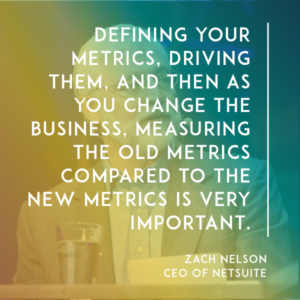
Defining your metrics, driving them, and then as you change the business, measuring the old metrics compared to the new metrics is very important. Having a good view on not losing your historical metrics are super important.
The second stage was really post IPO. When you go public you want to make sure you have enough control over the business that you’re not going to miss your numbers coming out of the gate, in fact, grow the numbers. I think it’s really mostly about executing in a big way at that time.
Probably one of the most important parts of execution is retaining your people. You build these great organizations, you go public, and then you don’t want these people to walk out the door and be picked off by somebody else.
Michael: Your initial set of metrics were all about deal size and how many deals are we closing and how many salespeople do we have. Eventually you started looking at internal metrics in addition to the external facing metrics.
Zach: Yeah, absolutely, as a company. One of the core, and I think we did this very well I’m really proud of what we’ve done here is we looked at our top 50 employees, because those are who your competitors are going to come and poach. We’d all been there for 10 years already. Everyone had already vested quite a bit of stock.
It was, “How do we retain these people?” Of course, there are non-financial things that you do to retain people, but then there are financial things you do to retain people. I think we put in a great system of really using an application called SpiraLinks. The CEO of SpiraLinks is here, Julie Southern.
My view of the world was there’s cash comp and then there’s stock comp. Silicon Valley is driven by stock comp. One of the beautiful things this application did for us was it gave us the ability to view the vesting of every employee over time so we knew when people were falling off cliffs.
We knew that developer was going to go from a million dollars of vesting to zero. You knew they were looking for a new job when it was zero. This has been an incredible tool and we continue to use now as a 5,000 person group.
The other thing that we did was when you go public, the first thing Wall Street asks you is, “What’s your next engine of growth?” We had teed up several next engines of growth. We knew they were going to work before we went public. We hadn’t told the world about them, but it was very important as we went public to have next generation ideas.
In our case, it was multi-company consolidation and e-commerce. But we knew they were going to work and we could really accelerate them in the face of public markets so that we could deliver on the expectations of our investors.
Then third, and this is the stage we’re in now, I call it scaling at scale. We’re a 5,000 person company on track to something like a billion this year in revenue. Last year, we added 1,400 employees. It’s an incredibly different challenge, obviously, to grow basically a NetSuite a year in many metrics at this scale.
I would say one of the best things we’ve done and one of the things I’m proudest about that this audience might look at is we built a distributed company very early on. When we were small, we knew we had to get out of the Bay Area for a whole host of reasons. Probably in Silicon Valley we have maybe 400 employees, but we have 5,000 employees in the company.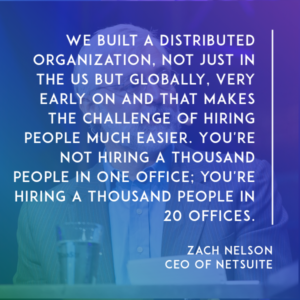
We built a distributed organization not just in the US but globally very early on, and that makes the challenge of hiring people much easier, when you’re not hiring a thousand people in one office. You’re hiring a thousand people in 20 offices.
Michael: You’re thinking about a multi-layered set of problems today, challenges today, and objectives today, whereas in the beginning, again, it was all about the sales.
Zach: The good news about it is, all those things we did in the past are still the basis for what we’re doing today, so we still look at our metrics and say, “How do we need to change these metrics? Do we need new metrics to drive the business?” That’s really the foundation of the company is what we did in those early years to grow.
Michael: Tell us about the metrics back then, and especially focusing on sales. How has that changed and how has your customer base changed over this time?
Zach: The biggest thing that’s changed over time was NetSuite was originally designed for small and midsize businesses. That DNA, cracking the code on how you sell complex applications to midsize companies is something almost no other company on the planet has done.
Most companies start by running up to the enterprise, because it’s an easier sales model. There are 500 companies in the Fortune 500 the last time I looked, so how do you sell to them? You hire 500 reps and you go after it.
When you’re selling to the Fortune Five Million, it’s a very different proposition. You can’t hire five million reps to get at them. That model is firm. I think we have by far the best sales and services model for mid market complex business applications. What happened as we grew was, we felt we were bringing the power of large enterprise systems to midsize businesses.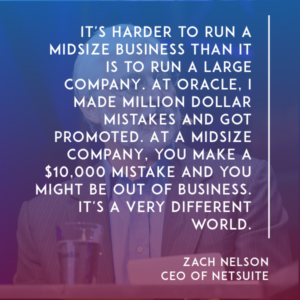
For those of you that run midsize businesses, you know it’s harder to run a midsize business than it is run a large company. In fact, I worked at Oracle. I made million dollar mistakes and I got promoted. At a midsize company, you make a $10,000 mistake, you might be out of business. It’s a very different world. Bringing the power of those large enterprises systems down was important.
What’s happened is, those large enterprises now want the agility of a small business in their business. Just as an example, AMEX Global Travel is probably one of our largest customers. They rolled out in nine months 30 countries, a 120 currencies, all live in nine months. You can’t do this on old ERP systems. That’s the agility that the larger companies are looking for.
Michael: As you went up market from smaller companies to now you sell to very large companies, what did that do to NetSuite? What did you have to do inside NetSuite to accommodate that change?
Zach: We had to extend the models I’d talked about in the very founding of the company – the sales model, service model and the product model. My best example of the problem with the mid market sales model applied to the enterprises, is the following one. We’d gotten our first deal that was an SAP replacement with a large multibillion dollar company. They wanted to buy NetSuite.
The CIO of the company, SAP has just come back with another $80 million bid. Stuffs doesn’t work, they wanted to charge us another 80 million to make it work, and I’m like, “Well, what did you tell them we cost? Did you tell them we were 40 million over five years or what was it?” He goes, “No, $400,000. That’s what I told them.”
That’s when you knew a mid market rep would take an enterprise deal and turn it into a mid market deal. I’m not talking about gouging people, it’s what’s the value we’re delivering that company. We are delivering more than $80 million of value. Arguably SAP didn’t work in that world. We should have been paid 80 million.
We had to add a new story to the house. An enterprise sales organization, an enterprise service organization. It was very important. The hard thing about doing that is, again, this mid market DNA we have. It’s so hard to figure out how to sell and service the Fortune five million. I did not want to lose that. You really have to create a new company that is targeted at the enterprise needs, the enterprise go to market.
Some of the things we changed on the go to market front on that side was, for the enterprise sales people, we don’t pay them on services at all. We want them to go to market with the GSIs and the Aperios of the world and the Deloittes. A lot of things that you change as you begin to look at that segment of the market, but the important thing for us was to make sure they were distinct companies, because it’s a completely different sales and delivery model.
Michael: You talk about services but for many SaaS founders the goal, and the ideal, is put the product out on the website, people sign up with their credit cards, you never hear from them again, and the money is flowing in, flowing in and flowing in. But with NetSuite, your product is complex, you’re a suite, it’s ERP and it doesn’t work in that simple pure way.
Zach: It would be great if every application were a Google search box and you just typed in and the money comes. That’s just not the way it works. As you talk about our company, and your company, there are going to be differences, there are going to be similarities.
At the end of the day, running a business is still a complex thing. People want to sell over the Internet. They want to use the Internet to reach customers but that doesn’t mean going from order to cash gets any simpler. That was one of the first fallacies.
It was the first fallacy of client server applications if you recall. There were back office guys like SAP and Oracle, there were front office, there were million CRM vendors and the customer would say, “Well, does your application work with that?” “Oh yeah. This is an API. You could tie Siebel to SAP. No problem.”
Michael: Yeah, it just works.
Zach: It just works.
Michael: All the stuff just works.
Zach: It doesn’t just work because the data is complex. That was the first big lie of the SaaS world too. “Oh, you can just tie this application to that application…tie 20 applications together.” Certainly, the web services make it easier to connect applications.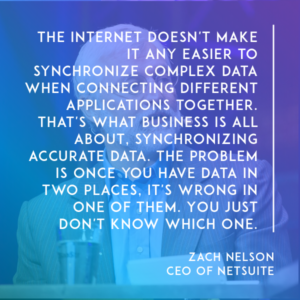
The challenge is, it doesn’t make it any easier to synchronize the data and that’s what business is all about, it’s synchronized accurate data. The problem is once you have data in two places, it’s wrong in one of them. You just don’t know which one.
Michael: You’re a business process company. It’s not a consumer app.
Zach: Ultimately, yeah.
Michael: Ultimately. The whole services thing, what did that do to the company? The recognition that you need to build this large services business inside the software company, what did that do to NetSuite?
Zach: I would say if you looked at our model, our customers are doing complex things with the software. We would have rather not built a services organization. However, we had to because we had to get the customers live. The whole idea, speaking to the choir here, is to make sure the revenue recurs. If the customer doesn’t get live, the revenue doesn’t recur.
At the time we started the company, not only did the world not believe this was going to be the future but especially in the mid market, this thing called the VAR channel definitely didn’t think this was the future. Their whole revenue stream was tied to the stone age applications that they were shocking into life every week for customers.
We had to build our own services team because there was no other alternative. We did it differently than a services business would. We felt services was an investment in the recurring. We told our customers, our investors today, we don’t plan to make any money on services, it’s an investment in the recurring and we make a little money on our services today but it’s really a necessary evil, not to say that services are evil.
We’re a software company. We had to have services and now I’m really happy to say that 40 percent of our business now comes through channel partners. That channel that was reticent 10 years ago is now driving our business today. That transition has happened but that was not there when we started the company.
Michael: Services then is the lever that drives the recurring software sale?
Zach: In our case, yeah. That was another interesting thing about our model, just to talk about history here. You have a lot of startups here. They want to reduce cash burn. The problem with running a cloud company is you have deferred gratification instead of getting paid upfront. You have it over 10 years, so you actually burn through more cash.
In the old days, we used to do three year deals. You can imagine how hard the sales model was. We’re $99 per month but we need 36 months upfront. That was really to reduce the cash burn. That’s not really the way you want to build a sustainable business.
And today, we changed our sales model many years ago to say, the way to align our interest with our customers interest, is to only do one year deals, because now we’re incented to make sure that customer gets live and they’re incented obviously to get live as well. That’s really a much better alignment. In the early days when you’re trying to conserve equity and cash burn, you do funny things.
Michael: What are some of the metrics that you use to correlate things like service, renewal rates, customer satisfaction, and your ultimate recurring revenue?
Zach: On the renewal rates it’s interesting when you have really companies that span very small businesses to very large businesses. Obviously, this end of the market churns much more quickly than this end of the market. We’ve always focused on revenue churn. In fact, our revenue churn is…every year we say it can’t get lower and then it gets lower again.
Obviously, our revenue churn when you take in, the bad side of revenue churn is churn and downsell, those are the negative inputs and the positive inputs are upsell. Year over year, our upsell always is more than our churn and downsell.
Again, as you all build company models, upsell is a very good thing so you need things to upsell to replace inevitable, even in a sticky application like ours, churn and downsell. That’s a very important piece of the model.
Michael: Tell us about the essence of success in upsell. How do you do it successfully?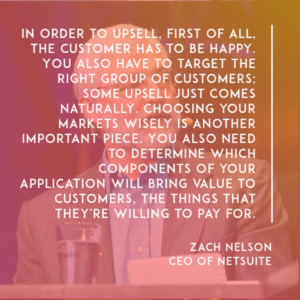
Zach: The customer has to be happy, first of all, to want to add more things. You also have to target the right group of customers. Some upsell just comes naturally. I think we’re probably the platform for 70 to 80 percent of next generation businesses such as here in the audience.
When they go from 50 employees to 500 employees, it’s a beautiful thing. Choosing your markets wisely is another important piece. I would say the third piece, and it goes back to my story of taking an $80 million deal and turning it into a $400,000 deal is really determine what are the components of your application that bring value to customers, the things that they’re willing to pay for.
Michael: I was going to ask about the link back to the product in this.
Zach: Yeah, and it’s really key. The way we used to look at it was we’re unusual from a SaaS model standpoint, because if you talk to most SaaS companies, they talk about per user, per month revenue. We certainly get per user, per month revenue. But we get far more revenue from the functionality of our application.
For example, when we introduce revenue recognition, we’re not going to add any more users in the finance department. In fact, they will probably fire the four guys, or redeploy the four people running the spreadsheet. But we’re bringing them enormous value. We look at, does the functionality add users or does it in some way subtract users and add automation value? We price that separately.
Michael: Let’s talk about competition.
Zach: Is there any?
Michael: I’ve heard that there are other companies selling ERP.
Zach: There are definitely people selling ERP. There are very few cloud…The amazing thing about our position in the world, it takes a long time to build this stuff.
Michael: I was going to say, it seems like every ERP company in the past that’s now presently alive is saying, “We’re cloud.” That’s the common refrain.
Zach: I love it too.
Michael: Why do you love it? These are your competitors.
Zach: This was the other Larry Ellison story way back when. He said the thing that made Oracle take off was when IBM declared they had a relational database. Of course, they didn’t have a relational database. It was nothing close to Oracle’s. But people began to look for relational databases and there was basically only one.
The same thing is happening here. If you look at NetSuite today, we’re top 10 market share in financial management. We’re number 10, but by far the fastest growing. If you look to the left of us, all these people claiming cloud, it’s the graveyard of software. Microsoft Great Plains. Epicor, Infor…these are just ugly, ugly products.
[laughter]
Zach: They are. Does anybody use this stuff? You can’t use it. It’s completely unusable.
Michael: He doesn’t mince words, does he?
Zach: They’re in the first generation of cloud washing. “Look, you can host our application.” None of it works. You have to rewrite these applications from the ground up, and oh by the way, you have to do it correctly.
You look at what SAP did with Business by Design. They spent three billion dollars on this thing and instead of copying NetSuite they thought they knew better and the thing was a massive three billion dollar flop. It doesn’t really exist anymore.
It’s not just desire, but you actually have to execute. But it’s very difficult for the guys on the old applications to execute.
Michael: But in fairness, some of these competitors, like SAP, do have a lot of revenue.
Zach: They have a lot of revenue, but even today, when SAP talks about their cloud applications, it’s all products they’ve acquired. They have not built a single cloud database…It’s Success Factors and Concur. Where is their cloud-based ERP offering? It does not exist.
Michael: When you think about differentiation, when I look at ERP websites, it seems most of the ERP vendors are giving very similar marketing messages. How do you differentiate NetSuite, and obviously, you’re growing very rapidly so you’re doing it really well, how do you differentiate NetSuite against both these established companies as well as there are quite a number of smaller cloud based ERP companies that have sprung up in the last number of years as well.
Zach: In truth, we never really built an ERP system. We built a system to run a business. The system that everybody runs their business on first and foremost is the back office. We have enormous differentiation in terms of how people use that application. If you look today, we have a thriving business in omni channel retail.
You don’t buy SAP to do omni channel retail. Our system does it as an accident of the architecture. We discovered very early on our customers have their inventory data, their warehouse data, their order management data, their customer data.
It’s all sitting in NetSuite. It was built on the Internet, so instead of making it look like a business application, we said, “Couldn’t our customers just put their website on top of that same data?” Lo and behold, they could.
It all comes back to really the founding vision of our company and the founding visions of your company. The thing that you start to build 20 years ago really defines where you can go in the future. This idea that Larry and Evan had of building a system to run a business, which nobody had ever done, and which today still no one has done.
You look at the way you run your businesses, how many applications do you have tied together, that’s still the big idea and that’s still what gives us leverage over other ERP vendors. It’s not about taking PeopleSoft and putting it on the cloud. That’s a failed 1980s architecture. It’s about enabling companies to do something very different with their business and I think that’s the platform we’ve built.
Michael: The ultimate success point, then, is the reference back to the original vision of the company and you’ve executed and you’ve expanded it in many ways.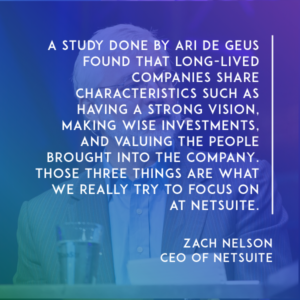
Zach: I’ve gotten philosophical as I’ve been in this job for almost 20 years now. Done some research. There was a researcher from Shell that said, “What really makes for the longest lived companies?” A guy named Ari de Geus did the study. He found there were three things to the longest lived companies.
The number one thing was the vision of the company. The example he used was the Dutch West Indies Trading Company, which is arguably the oldest company on the planet. He said if they’d called themselves, or if they were the Dutch West Indies Spice Company, they would have died when the spice trade died. But they were a trading company so they built their core DNA around trading and they grew and grew and grew. Your initial choices in how you build your businesses really is super important.
The second important piece that he found was financial management. People always look at a cloud company and say, “Doesn’t that mean you should be profitable?” No. It means you should invest wisely.
I think that’s something we’ve done as a company particularly well. We raised a hundred million dollars before we went public, and that’s almost bootstrapping it today. A lot of companies are raising 500 million, a billion dollars to run these companies. We invested heavily in sales and service and marketing, because we felt that was the important place to invest, and it’s paid off, so wise investments.
Then finally, and I talked about this in my middle section, the third important piece was the people. Who you hire, the jobs you put them in, how they grow with the company. That’s what we really try to focus on at NetSuite are those three things – vision, financial management, and the people that we bring onboard.
Michael: Fantastic. It’s been quite a journey.
Zach: It has been. It’s great.
Michael: Thank you so much. Everybody, Zach Nelson.
Zach: Appreciate it.
